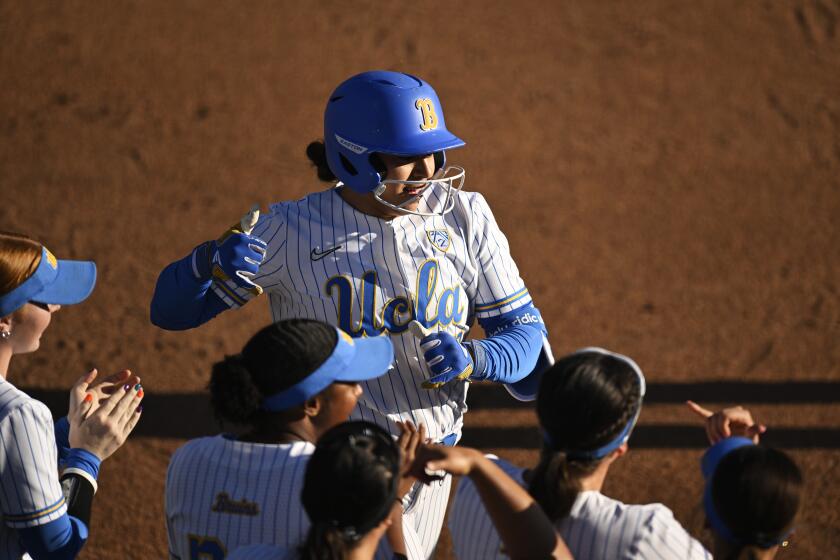An L.A. goal just beyond his grasp
Patrick Lynch has racked up one of the worst losing streaks in the world of sports. He’s 0 for 13 years.
That’s how long Lynch has tried -- and failed -- to lure an NFL franchise back to the Los Angeles Memorial Coliseum, the beloved but benighted venue that he runs as general manager.
Lynch has been told “No” so often that the word seems to echo in his wake, like his own footsteps. In their hunt for professional football, Lynch and his employer, the Coliseum Commission, have been outfoxed by lower-tiered locales such as Houston, and have taken more hits than a blocking dummy from team owners, fans, media commentators and politicians.
But there’s another side of the story, which many Coliseum-bashers might find surprising. Despite all the rejected NFL plans and all the talk that the 85-year-old property at Exposition Park is unmarketable, the yawning stadium and its companion Sports Arena actually make money.
“We’re doing very well,” Lynch said while standing at the Coliseum’s peristyle, its iconic columns lined with plaques commemorating past triumphs. “Nobody could ever say that we’re not fiscally aggressive.”
Plenty of less flattering things have been said. It’s gotten so ugly that two state legislators from Irvine and Merced have proposed selling the land out from under the Coliseum, the site of two Olympiads.
Even the Coliseum’s sole remaining tenant, USC football, threatened to bolt to Pasadena’s Rose Bowl, never mind that the school is just across the street.
“I have the toughest skin,” said Lynch, 50.
An accountant by training, he keeps the nonprofit commission in the black by booking the Coliseum with more futbol than football, and by leasing out the Sports Arena to giant rave parties, Bruce Springsteen concerts and an ongoing shoot of “American Gladiators,” not to mention ice shows and used car sales.
The whole enterprise -- jointly and awkwardly owned by the state, county and city -- is netting about $2 million annually in operating income, according to its financial statements. It was bleeding cash early in Lynch’s tenure, which began the year before the Los Angeles Raiders left for Oakland, the blow that launched him on his fruitless campaign to win back the NFL.
“The vast majority of municipal venues do not make money,” he said, noting that the “Gladiators” filming alone will dump hundreds of thousands of dollars into the commission’s coffers. “We’ve had some tough times. We’ve had bad years when we’ve lost money. But we’ve slowly rebounded and we’re fine now.”
Trojan football accounts for well over half of the Coliseum’s revenues, although nearly two-thirds of the commission’s total -- Sports Arena receipts included -- comes from non-USC events, Lynch said.
Among last year’s draws were a Mexico vs. Guatemala soccer match, Latin dance performances, a Cinco de Mayo festival and a robotics contest.
“We’ve maintained our competitiveness even when people didn’t believe in us,” Lynch said. “People say, ‘What goes on down there? How are you even alive?’ ”
In other words: How could the Coliseum continue to survive without the NFL?
After a nasty public relations fight, the commission and USC recently reached a tentative 25-year lease agreement that gives the school veto power over any bid to return the NFL to the Coliseum. USC administrators have long complained that the commission allowed the stadium to deteriorate, its concourses shedding chunks of concrete, as it chased its NFL dream.
The university has negotiated a key provision that requires the Coliseum to retain at least 90,000 permanent seats -- a number that the Trojans have little trouble filling but that is perhaps 20,000 more than an NFL team would want.
USC insists that it would consider sharing quarters with the pros, but Lynch and others say the pact makes landing a franchise a Hail Mary pass at best.
Lynch adds that he never really bought the notion that USC would uproot itself for Pasadena.
“The Rose Bowl?” he sniffed. “The Rose Bowl loses $2 million a year.” As he walked through the peristyle, the Massachusetts native said he was focusing on a future for the Coliseum without the NFL, complete with a top-to-bottom stadium upgrade, a naming-rights deal to pay for the improvements and as many as 15 international soccer showcases.
“We’re moving ahead,” Lynch said.
And yet he couldn’t resist casting a wistful gaze across the empty Coliseum stands, toward what could have been a mirage of good times gone. A baseball diamond was taking shape at the far end of the gridiron. The infield was in place and cranes were hoisting a towering frame for netting along the shallow left field fence.
On Saturday, the makeshift ballpark will host an exhibition game between the Los Angeles Dodgers and Boston Red Sox to mark the blue crew’s arrival at the Coliseum 50 years ago. The team stayed until Dodger Stadium debuted in 1962.
Back then, the Coliseum was also home to the Los Angeles Rams, and the USC and UCLA football teams. The Los Angeles Chargers of the old American Football League set up shop at the Coliseum in 1960 on their way to San Diego.
Meanwhile, the Sports Arena reigned as the house of the Los Angeles Lakers.
“Those were the glory days,” Lynch said as he watched the cranes under the midday sun.
He said he knew the commission expected him to scramble when it hired him away from a Philadelphia-based management firm, for which he had helped build a basketball and hockey arena in Albany, N.Y. At the time, the Raiders were making noises about abandoning the Coliseum if the commission did not install luxury boxes.
Exposition Park already had a legion of ghosts. The Rams left for Anaheim after the 1979 season (they moved to St. Louis 15 years later). UCLA decamped for the Rose Bowl in 1982, the same year the Raiders relocated here from Oakland. The Lakers had departed for the Forum in Inglewood in late 1967.
Tall and affable, Lynch is a football fan first and foremost; he co-owns a sports bar in Redondo Beach, where he still roots for the Raiders “to a certain extent.” So it stung when the team carried out its ultimatum to retreat to Oakland just as he was settling into his job.
He tried in vain to dissuade the Los Angeles Clippers, a Sports Arena presence since 1984, from joining the Lakers and Kings at the new, glammed-up Staples Center in 1999.
“This building could have been Staples,” Lynch said, lifting his hands as he sat in his cluttered office in the tired, dim-windowed Sports Arena, which opened in 1959. He shook his head at what might have been.
Replacing the Sports Arena with a state-of-the-art basketball palace was among the many projects he pitched -- unsuccessfully -- when he wasn’t busy pursuing the NFL.
The commission also informally offered to turn the arena, as is, over to the resident USC basketball team. The school elected instead to build the Galen Center, and the team moved there in 2006.
Many of the commission’s former tenants have said they were happy to part company with the panel because of its unwieldiness -- its nine members represent three levels of government -- and its penchant for turf battles.
For the most part, Lynch has been spared in the attacks on the commission and is given high marks for nimbly serving so many masters.
“They’ve stumbled and fumbled over and over again,” state Sen. Mark Ridley-Thomas (D-Los Angeles), whose district includes the Coliseum, said of the commissioners.
A former panel member, he has been pushing for an NFL team since the Raiders left, but doesn’t blame Lynch for not getting into the end zone.
“He’s a very bright guy, he’s very dedicated, he understands economic development,” said Ridley-Thomas, who wants to create an Exposition Park authority to supplant the commission and sell the Sports Arena. “He has a lot of audiences to deal with.”
USC’s Kristina Raspe, who handled the negotiations for the lease, is less effusive about Lynch.
“He was pleasant to deal with,” she said.
Lynch’s face darkens when he is asked about USC. He says the Trojans blindsided him with their Rose Bowl threat because he had been working on the school’s demands all along, with or without the NFL.
“We didn’t think it was a classy move,” he said of USC’s tactic.
Commissioners say their reputation for being rudderless is largely undeserved but they acknowledge some institutional shortcomings, which Lynch has had to live with.
Pieced together in the 1940s, the commission has been hamstrung by a lack of government subsidies that could finance improvements to the Coliseum and Sports Arena. It is a self-supporting operation that depends on lease fees, ticket purchases and concession sales to pay the bills. (In lean years, the commission has been forced to take out bank loans, but is now debt-free.)
Complicating its efforts to woo the NFL is the fact that the Coliseum has been a National Historic Landmark since 1984, the year of its second Olympic Games (the first was in 1932). The designation could prohibit a NFL team from razing the Coliseum to erect the sort of glitzier stadium that teams prize.
Nevertheless, Lynch did come close to bagging a franchise. Two years ago, he and his bosses cleared a welter of land-use and jurisdictional hurdles to present the NFL with a plan for a thoroughly remodeled Coliseum that met the league’s design needs.
After more than a decade of false starts, everything finally had appeared to be in place. Media reports indicated that it had become a question of when, not if, professional football would be back in Exposition Park.
Then the NFL walked away, blanching at the blueprint’s estimated $800-million to $1-billion price tag.
It was another no, and endures as a painful memory for Lynch. During his courtship of the NFL, he has logged tens of thousands of travel miles and untold hours in brainstorming and negotiating sessions, working through a roster of prospective investors in a team.
He counted some of the moguls on the list: “Eli Broad, many, many meetings. Ed Roski, many, many meetings. Mike Ovitz, many, many meetings.”
Many, many noes.
But there’s always international soccer, whose popularity in Los Angeles has grown in step with Latino immigration. Last month, a Coliseum match between Argentina and Guatemala drew 35,000.
That hardly compares to a USC homecoming game, or the crowds an NFL team could bring.
And the commission did make more money when the Raiders were in town.
Lynch, however, is glad for the yeses he hears from the foreign version of football.
“It’s turned out to be a very, very good business for us,” he said.
--
More to Read
Get our high school sports newsletter
Prep Rally is devoted to the SoCal high school sports experience, bringing you scores, stories and a behind-the-scenes look at what makes prep sports so popular.
You may occasionally receive promotional content from the Los Angeles Times.







